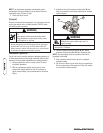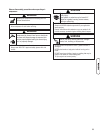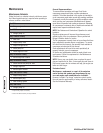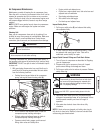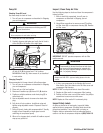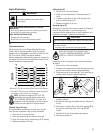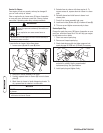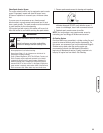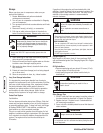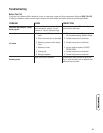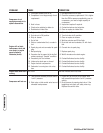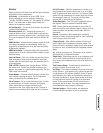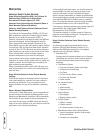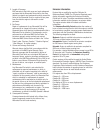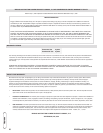
Storage
Before you store your air compressor, make sure you
perform the following:
1. Review Maintenance and perform scheduled
maintenance as necessary.
2. Turn off your air compressor as described in Stopping
your air compressor.
3. Turn pressure control knob counterclockwise until knob
turns freely.
4. Remove air hose(s), air tool(s), or accessories.
5. Pull ring on safety valve and drain air from both air
tanks to reduce air pressure. Release safety valve ring.
6. Drain remaining air and water from tanks by opening
drain valves fully counterclockwise.
7. Rock unit forward and back to agitate water as it drains
to obtain a more thorough emptying action.
8. After water has been drained, close both drain valves
fully clockwise.
9. Protect air hoses from damage (such as being stepped
on or driven over).
10. Store air compressor in clean, dry, indoor location.
Long Term Storage Instructions
It is important to prevent gum deposits from forming in
essential fuel system parts, such as the carburetor, fuel filter,
fuel hose or tank during storage. Also, experience indicates
that alcohol-blended fuels (called gasohol, ethanol or
methanol) can attract moisture, which leads to separation
and formation of acids during storage. Acidic fuel can
damage the fuel system of an engine while in storage.
Protect Fuel System
Fuel Additive:
Fuel can become stale when stored over 30 days. Stale fuel
causes acid and gum deposits to form in the fuel system or
on essential carburetor parts. To keep fuel fresh, use Briggs
& Stratton FRESH START™ fuel stabilizer, available as a
liquid additive or a drip concentrate cartridge.
There is no need to drain gasoline from the engine if a fuel
stabilizer is added according to instructions. Run the engine
for 2 minutes to circulate the stabilizer throughout the fuel
system. The engine and fuel can then be stored up to
24 months.
If gasoline in the engine has not been treated with a fuel
stabilizer, it must be drained into an approved container. Run
the engine until it stops from lack of fuel. The use of a fuel
stabilizer in the storage container is recommended to
maintain freshness.
Change Engine Oil
While engine is still warm, drain oil from crankcase. Refill
with recommended grade. See Changing Engine Oil in Engine
Maintenance.
Oil Cylinder Bore
• Remove spark plug and pour about 1/2 ounce (15 ml)
of clean engine oil into the cylinder.
• Install spark plug and pull starter handle slowly to
distribute oil.
Other Storage Tips
1. DO NOT store fuel from one season to another unless it
has been treated as described in Protect Fuel System.
2. Replace fuel can if it starts to rust. Contaminated fuel
will cause engine problems.
3. Cover unit with a suitable protective cover that does not
retain moisture.
20 BRIGGSandSTRATTON.COM
WARNING
Compressed air stream from hose or tank drain
can cause soft tissue damage to exposed skin
and can propel objects leading to severe injury
and / or property damage.
• DO NOT direct air stream at self or others.
• Always wear ANSI Z87.1 approved safety glasses with side
shields.
WARNING
Fuel and its vapors are extremely flammable and
explosive.
Fire or explosion can cause severe burns or
death.
WHEN STORING FUEL OR EQUIPMENT WITH FUEL IN TANK
• Store away from furnaces, stoves, water heaters, clothes dryers,
or other appliances that have pilot light or other ignition source
because they can ignite fuel vapors.
WHEN DRAINING FUEL
• Turn air compressor OFF and let it cool at least 2 minutes before
removing fuel cap. Loosen cap slowly to relieve pressure in tank.
• Drain fuel tank outdoors.
• Keep fuel away from sparks, open flames, pilot lights, heat, and
other ignition sources.
• DO NOT light a cigarette or smoke.
WARNING
Unintentional sparking can result in fire or
electric shock.
• NEVER pull starter handle with spark plug removed.
WARNING
Storage covers can be flammable.
• DO NOT place a storage cover over a hot air compressor.
• Let equipment cool for a sufficient time before placing the cover
on the equipment.



